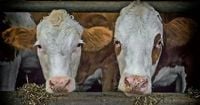The agricultural landscape in Moldova has taken a hit, with recent statistics revealing a significant downturn in production during the first quarter of 2025. According to the National Bureau of Statistics, there was a notable overall decline of 9.5% in agricultural production across all categories of farms, primarily attributed to a 10% drop in animal production, which constitutes a staggering 97.4% of the total agricultural output.
In a detailed breakdown of the figures, the statistics show that the production of animals, measured in live weight, fell by 15.1% compared to the same period last year. This decline was primarily driven by a steep decrease in agricultural enterprises, which reported an 18.4% reduction, while households saw a smaller decrease of 5.8%. The impact of these figures is felt across the agricultural sector, highlighting a troubling trend for farmers and consumers alike.
Interestingly, while animal production faced a downturn, there were some bright spots in other areas. Milk production across all categories of farms saw a slight increase of 0.6%, largely fueled by a remarkable 19.7% rise in production from agricultural enterprises. However, it’s worth noting that milk production in households decreased by 4.5%, indicating a mixed performance in this sector.
Egg production also experienced a boost, increasing by 2.9% overall, thanks to a 6.9% rise in agricultural enterprises. Conversely, households reported a 6.6% decrease in egg production, suggesting that the challenges faced by smaller farms are impacting their ability to meet demand.
The decline in animal production is particularly concerning, as it has been linked to a significant reduction in the livestock population, especially pigs. At the end of the first quarter, the number of pigs had decreased by 18.9% compared to the same date last year, with agricultural enterprises experiencing an even sharper decline of over 25%. This reduction has been largely attributed to the ongoing African swine fever outbreak, which has wreaked havoc on pig farms across the country.
As the agricultural sector grapples with these challenges, the decrease in livestock numbers has been somewhat mitigated by an increase in other categories of animals. The number of cattle, sheep, goats, and birds in agricultural enterprises saw increases of 2.9%, 7.2%, and 15.1%, respectively. However, this positive trend was not mirrored in households, where the number of animals across all species has declined.
These statistics raise critical questions about the future of Moldova's agricultural sector. With the significant drop in animal production and the challenges posed by diseases like African swine fever, farmers are left to navigate a precarious landscape. The reliance on agricultural enterprises for production increases may not be sustainable if household production continues to wane.
Moreover, the overall decline in agricultural output could have broader implications for food security in Moldova. As production decreases, consumers may face higher prices and reduced availability of essential goods, particularly meat and dairy products. This situation calls for urgent attention from policymakers and industry leaders to support farmers and stabilize the agricultural sector.
In summary, the agricultural production figures for the first quarter of 2025 paint a concerning picture for Moldova. While there are areas of growth, such as milk and egg production in agricultural enterprises, the overarching trend of declining animal production and livestock numbers cannot be ignored. As farmers continue to face challenges from disease outbreaks and market pressures, the need for strategic interventions becomes increasingly clear.




